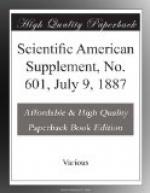+------------------------------------------------------
--------------+ | | Highest | Price on | Price on | | | Price | March 30, | March 30, | | | | 1886 | 1887 | | |--------------+---------------+---------------+ | | per gal. | per gal. | per gal. | | |----+----+----+---+-----------+---------------+ | | L | s. | d. | L | s. | d. | L | s. | d. | | |----+----+----+----+----+-----+----+----+-----+ |Crude naphtha | 0 | 4 | 0 | 0 | 0 | 41/2 | 0 | 0 | 81/2 | |Benzol (90 per cent.)| 0 | 15 | 0 | 0 | 1 | 4 | 0 | 2 | 6 | |Solvent naphtha | 0 | 2 | 6 | 0 | 1 | 0 | 0 | 1 | 2 | |Burning naphtha | 0 | 1 | 7 | 0 | 0 | 101/2 | 0 | 0 | 10 | |Creosote oil | 0 | 0 | 3 | 0 | 0 | 03/4 | 0 | 0 | 1 | | | | | | | | per ton. | per ton. | per ton. | | |----+----+----+----+----+-----+----+----+-----+ | | L | s. | d. | L | s. | d. | L | s. | d. | | |----+----+----+----+----+-----+----+----+-----+ |Pitch | 1 | 14 | 0 | 0 | 15 | 0 | 0 | 12 | 6 | |Sulphate of ammonia | 21 | 5 | 0 | 13 | 10 | 0 | 11 | 10 | 0 | +-----------------------------------------------------------
---------+
This shows a great fall in value from highest to lowest, which seems to have been touched last year, except in the case of pitch and sulphate of ammonia, both of which have marked a considerable decline, even since last year, but it is pleasing to note that the others have shown at least some slight improvement—crude naphtha and benzol having during the year risen nearly one hundred per cent. in value. Let us hope that this is the precursor of a general rise in value from which we shall all profit. For the purpose of bringing about this much desired end, I understand that some of the gentlemen present to-day have been burning their tar in the retort furnaces, and as it will be interesting to know what success they have attained, I hope some of them will favor us with their experience on this subject.
In conclusion, let me express the hope that the time is not far distant when the general trade of the country will attain to its wonted prosperity, by which every branch of industry will benefit—ours among the number; and that the hard times we have experienced, now for a considerable number of years, may not again return.
Discussion next took place regarding the Welsbach incandescence gas light, which was opened by Mr. McGrilchrist, who remarked on the very fragile and tender nature of the “mantle,” and expressed a hope that in this direction improvement might be looked for. It was certainly a beautiful light, and as to its consumption, he stated that the lamp then shown to the meeting was only burning two cubic feet of gas per hour. [A voice: Two and two-tenths.] He felt satisfied that it would enable the manufacturers of gas to compete with paraffin oil, so that with Glasgow gas they could have such a light as they saw at the rate of 4d. for about fifty hours.




